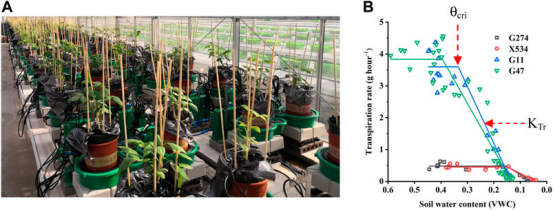品质至上,客户至上,您的满意就是我们的目标
当前位置: 首页 > 新闻动态
科学家利用Plantarray植物逆境系统在Front. Genet.发表表型研究新文章
发表时间: 点击:812
来源:北京博普特科技有限公司
分享:
最近,科学家利用Plantarray植物逆境系统发表了题为Unraveling the Genetic Architecture of Two Complex, Stomata-Related Drought-Responsive Traits by High-Throughput Physiological Phenotyping and GWAS in Cowpea (Vigna. Unguiculata L. Walp)的文章,文章发表于期刊 Front. Genet.上,
通过豇豆的高通量生理表型和GWAS揭示两个复杂气孔相关干旱响应性状的遗传结构
干旱是农业中最严重和最频繁的非生物胁迫之一。虽然许多形态、生化和生理指标被用来量化植物的干旱反应,但气孔控制以及通过气孔控制的蒸腾和光合作用调节,在衡量植物平衡胁迫反应和产量的能力方面尤为重要。由于在进行性土壤干旱条件下难以同时大规模测量气孔特征,如气孔关闭的敏感性和速度,此类重要行为的正向遗传图谱长期以来一直无法使用。最近出现的物候技术为确定整个植物的水分关系和在种群水平上分析动态过程中的气孔调节提供了解决方案。在此,我们报告了106份豇豆材料在渐进干旱胁迫下水分关系的高通量生理表型,结合全基因组关联研究(GWAS),可以对复杂的气孔相关干旱响应性状“临界土壤含水量”(θcri)和“蒸腾速率下降斜率”(KTr)进行研究。106份材料的θcri和KTr差异较大,表明它们对土壤水分亏缺具有广泛的气孔控制,这可能赋予它们不同程度的耐旱性。单变量GWA分别鉴定了6个和14个与θcri和KTr相关的重要SNP。检测到的SNP分布在9条染色体上,占表型变异的8.7–21%,表明气孔对土壤干旱的敏感性和气孔关闭乃至完成的速度均由多个基因控制,具有调节效应。多变量GWA检测到10个更显著的SNP,此外确认了20个SN中的8个通过单变量GWAS检测到的P。综合,报告了与气孔关闭相关的最终30个重要SNP。综上所述,我们的工作通过结合表型组学和遗传学,实现了与耐旱性相关的气孔性状遗传结构的正向遗传图谱,这不仅为分子生物学研究提供了基础对豇豆抗旱品种进行芦苇育种,但为探索物候期胁迫条件下作物水分收支的遗传决定因素提供了一种新方法。

FIGURE 1. The PlantArray system used in the current study. (A) Top view of the automated physiological phenotyping array with 100 measuring units loaded with cowpea seedlings. (B) Illustration of the θθcri and KTr in four representative accessions.
Unraveling the Genetic Architecture of Two Complex, Stomata-Related Drought-Responsive Traits by High-Throughput Physiological Phenotyping and GWAS in Cowpea (Vigna. Unguiculata L. Walp)
ORIGINAL RESEARCH article
Front. Genet., 28 October 2021 | https://doi.org/10.3389/fgene.2021.743758
Xinyi Wu1, Ting Sun2, Wenzhao Xu3, Yudong Sun3, Baogen Wang1, Ying Wang1, Yanwei Li1, Jian Wang1, Xiaohua Wu1, Zhongfu Lu1, Pei Xu2* and Guojing Li1,4*
Drought is one of the most devasting and frequent abiotic stresses in agriculture. While many morphological, biochemical and physiological indicators are being used to quantify plant drought responses, stomatal control, and hence the transpiration and photosynthesis regulation through it, is of particular importance in marking the plant capacity of balancing stress response and yield. Due to the difficulties in simultaneous, large-scale measurement of stomatal traits such as sensitivity and speed of stomatal closure under progressive soil drought, forward genetic mapping of these important behaviors has long been unavailable. The recent emerging phenomic technologies offer solutions to identify the water relations of whole plant and assay the stomatal regulation in a dynamic process at the population level. Here, we report high-throughput physiological phenotyping of water relations of 106 cowpea accessions under progressive drought stress, which, in combination of genome-wide association study (GWAS), enables genetic mapping of the complex, stomata-related drought responsive traits “critical soil water content” (θcri) and “slope of transpiration rate declining” (KTr). The 106 accessions showed large variations in θcri and KTr, indicating that they had broad spectrum of stomatal control in response to soil water deficit, which may confer them different levels of drought tolerance. Univariate GWAS identified six and fourteen significant SNPs associated with θcri and KTr, respectively. The detected SNPs distributed in nine chromosomes and accounted for 8.7–21% of the phenotypic variation, suggesting that both stomatal sensitivity to soil drought and the speed of stomatal closure to completion were controlled by multiple genes with moderate effects. Multivariate GWAS detected ten more significant SNPs in addition to confirming eight of the twenty SNPs as detected by univariate GWAS. Integrated, a final set of 30 significant SNPs associated with stomatal closure were reported. Taken together, our work, by combining phenomics and genetics, enables forward genetic mapping of the genetic architecture of stomatal traits related to drought tolerance, which not only provides a basis for molecular breeding of drought resistant cultivars of cowpea, but offers a new methodology to explore the genetic determinants of water budgeting in crops under stressful conditions in the phenomics era.